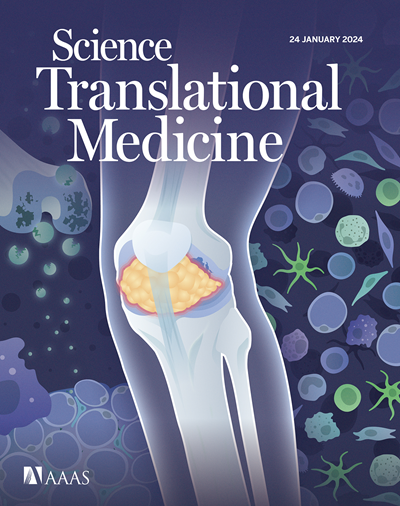A genome-wide in vivo CRISPR activation screen identifies BACE1 as a therapeutic vulnerability of lung cancer brain metastasis
IF 14.6
1区 医学
Q1 CELL BIOLOGY
引用次数: 0
Abstract
Brain metastasis occurs in up to 40% of patients with non–small cell lung cancer (NSCLC). Considerable genomic heterogeneity exists between the primary lung tumor and respective brain metastasis; however, the identity of the genes capable of driving brain metastasis is incompletely understood. Here, we carried out an in vivo genome-wide CRISPR activation screen to identify molecular drivers of brain metastasis from an orthotopic xenograft model derived from a patient with NSCLC. We found that activating expression of the Alzheimer’s disease–associated beta-secretase 1 (BACE1) led to a substantial increase in brain metastases. Furthermore, genetic and pharmacological inhibition of BACE1 blocked NSCLC brain metastasis. Mechanistically, we identified that BACE1 acts through epidermal growth factor receptor to drive this metastatic phenotype. Together, our data highlight the power of in vivo CRISPR activation screening to unveil molecular drivers and potential therapeutic targets of NSCLC brain metastasis.
一项全基因组体内CRISPR激活筛选发现BACE1是肺癌脑转移的治疗易感性
高达40%的非小细胞肺癌(NSCLC)患者发生脑转移。原发性肺肿瘤与相应的脑转移瘤之间存在相当大的基因组异质性;然而,能够驱动脑转移的基因的身份尚不完全清楚。在这里,我们进行了一项体内全基因组CRISPR激活筛选,以鉴定来自非小细胞肺癌患者的原位异种移植模型脑转移的分子驱动因素。我们发现,激活阿尔茨海默病相关β -分泌酶1 (BACE1)的表达导致脑转移的大幅增加。此外,基因和药理抑制BACE1可阻断NSCLC脑转移。在机制上,我们发现BACE1通过表皮生长因子受体来驱动这种转移表型。总之,我们的数据强调了体内CRISPR激活筛选在揭示非小细胞肺癌脑转移的分子驱动因素和潜在治疗靶点方面的力量。
本文章由计算机程序翻译,如有差异,请以英文原文为准。
求助全文
约1分钟内获得全文
求助全文
来源期刊

Science Translational Medicine
CELL BIOLOGY-MEDICINE, RESEARCH & EXPERIMENTAL
CiteScore
26.70
自引率
1.20%
发文量
309
审稿时长
1.7 months
期刊介绍:
Science Translational Medicine is an online journal that focuses on publishing research at the intersection of science, engineering, and medicine. The goal of the journal is to promote human health by providing a platform for researchers from various disciplines to communicate their latest advancements in biomedical, translational, and clinical research.
The journal aims to address the slow translation of scientific knowledge into effective treatments and health measures. It publishes articles that fill the knowledge gaps between preclinical research and medical applications, with a focus on accelerating the translation of knowledge into new ways of preventing, diagnosing, and treating human diseases.
The scope of Science Translational Medicine includes various areas such as cardiovascular disease, immunology/vaccines, metabolism/diabetes/obesity, neuroscience/neurology/psychiatry, cancer, infectious diseases, policy, behavior, bioengineering, chemical genomics/drug discovery, imaging, applied physical sciences, medical nanotechnology, drug delivery, biomarkers, gene therapy/regenerative medicine, toxicology and pharmacokinetics, data mining, cell culture, animal and human studies, medical informatics, and other interdisciplinary approaches to medicine.
The target audience of the journal includes researchers and management in academia, government, and the biotechnology and pharmaceutical industries. It is also relevant to physician scientists, regulators, policy makers, investors, business developers, and funding agencies.
 求助内容:
求助内容: 应助结果提醒方式:
应助结果提醒方式:


